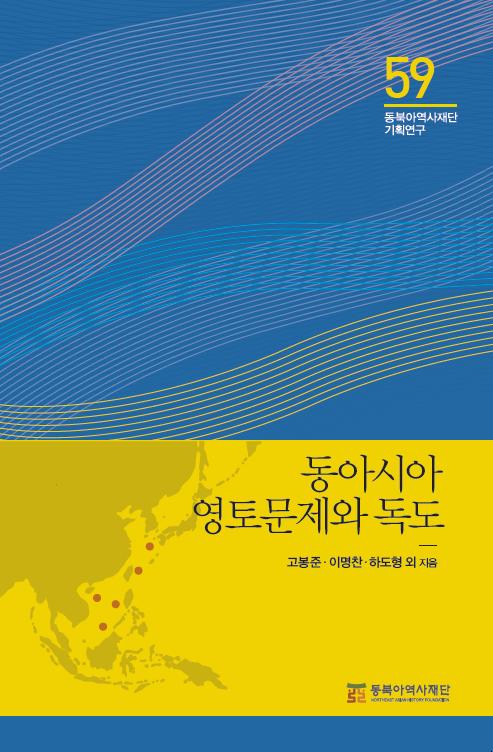Publication
- Date2015.03.25
- Hit893

1. All rights reserved by the Northeast Asian History Foundation
2. No part of the files on this website may be reproduced and/or copied in any way, shape, or form without permission.
Title: Territorial Issues in East Asia and Dokdo
By KO Bong-joon; LEE Myong-Chan; HA Do-hyung et al.
Northeast Asian History Foundation | 225*152mm (A5 New) | 420 pages | KRW 15,000 | December 31, 2013
ISBN 978-89-6187-319-2 93910
This book consists of seven papers produced through a research project including: a study on the positions of China and Japan projected through their diplomatic struggle over the sovereignty of the Senkaku Islands; a study on the territorial policies of Japan and Russia in a tiring duel over the recession of four of the Kuril Islands; a study on the trends of ongoing issues between China and its neighboring countries over territorial land and water in the South China Sea; and a study on the U.S. position on territorial issues in East Asia and the cases in which territorial disputes have been resolved. For these studies, seven committed researchers convened several times to present, discuss, and continually adjust the direction of their research project. Research methods also involved attending international conferences on territorial issues or conducting interviews with leading experts on territorial issues. Hopefully, findings from these studies can inspire those in charge of policies to protect Korea’s sovereignty over Dokdo, as well as researchers in devising countermeasures toward Japan’s recently intensifying provocations targeting Dokdo.
Contents
● East Asia’s Maritime Territorial Issues and the Unites States | KO Bong-joon
-Re-balancing and Multi-faceted Responses
Ⅰ. Introduction
Ⅱ. The U.S. National Strategy and East Asia
Ⅲ. East Asia’s Maritime Territorial Issues and the U.S. Position
Ⅳ. Implications for Dokdo and Ieodo
Ⅴ. Conclusion
● China-Japan Conflict Surrounding the Senkaku Islands and Japan’s Response | LEE Myong-Chan
Ⅰ. Introduction
Ⅱ. The Progress and Details of the China-Japan Conflict
Ⅲ. Issues with the Senkakus
Ⅳ. Cause of the Senkaku Conflict between China and Japan
Ⅴ. Conclusion: Implications for the Dokdo Issue
● China’s Perception and Response to the Intensifying Diaoyu Dao Dispute | HA Do-hyung
Ⅰ. Introduction
Ⅱ. Issues with the Historical Origin of Diaoyu Dao
Ⅲ. Developments of the Diaoyu Dao Dispute’s Reignition and Unfolding
Ⅳ. Causes that Intensified the Diaoyu Dao Dispute and Invoked Strong Response from China
Ⅴ. The Diaoyu Dao Dispute’s Implications for Dokdo
Ⅵ. Conclusion
● The Russian Kuril Islands (Four Northern Islands) Policy | KIM In-seong
Ⅰ. Introduction
Ⅱ. Territorial Dispute between Russia and Japan: Development and Issues
Ⅲ. The Kuril Dispute and Public Opinion in Russia
Ⅳ. Policy toward the Kuril Islands since the Dispute’s Intensification
Ⅴ. The Kuril Dispute and Leadership
Ⅵ. The Kuril Dispute’s Political Implications
Ⅶ. Conclusion
● The Kuril Islands Dispute: Historical Background and Current Status | NAM Sang-gu
-Focusing on the Japanese Government’s Response
Ⅰ. Introduction
Ⅱ. The Japanese Government’s Policy Regarding the Kuril Islands Issue
Ⅲ. Russian President Medvedev’s Visit to the Kuril Islands
Ⅳ. Conclusion: Recent Trends and Implications
● The Spratly Islands Issue and Responses of the Nations Involved | KIM Dong-wook
Ⅰ. Introduction
Ⅱ. Responses of the Nations Involved
Ⅲ. Resolution
Ⅳ. Conclusion
● Analysis of the China-Russia Territorial Dispute | YOON Tae-ryong
- Cause of the Dispute’s Settlement and Applied Principle, and Implications for the Dokdo Issue
Ⅰ. Introduction
Ⅱ. Historical Background of the China-Russia Territorial Dispute
Ⅲ. The Main Cause of the 1969 Chenpao Island Dispute and the China-Russia Territorial Dispute 305
Ⅳ. The Process and Cause of the China-Russia Territorial Dispute’s Settlement
Ⅴ. Principles Applied over the Process of Settlement of the Two Countries’ Territorial Issue
Ⅵ. Conclusion: Theoretical and Policy Implications of the China-Russia Territorial Dispute’s Settlement, and Dokdo
